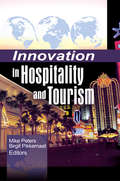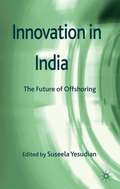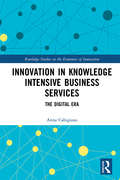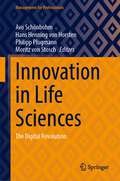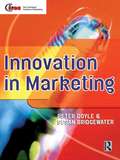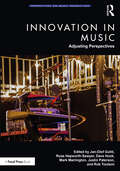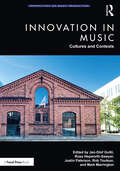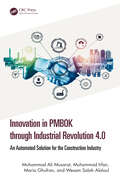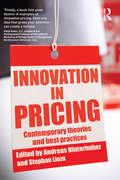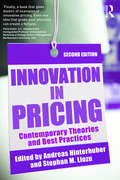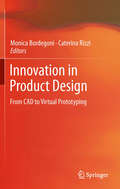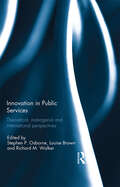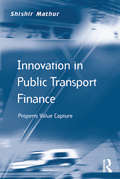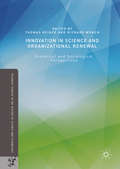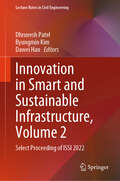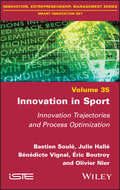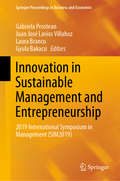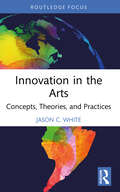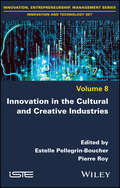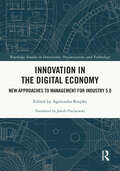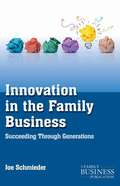- Table View
- List View
Innovation in High Reliability Ambidextrous Organizations: Analytical Solutions Toward Increasing Innovative Activity (Contributions To Management Science Series)
by Jan KranerCompanies need to invest in innovation in order to ensure their long-term survival. This book focuses on how and why key players support or obstruct the implementation of a technological innovation in ambidextrous organizations, and how the interaction between players involved in daily business and innovation affects implementation of innovation in 'high reliability organizations'.This book argues that an organization has to create new innovations or adopt innovations to constantly deliver attractive products on the one hand, while also adjusting and improving current products and processes on the other. In turn, it addresses a specific problem: What if a company operates in an innovation-averse and procedural environment and culture? Drawing on case studies, focus group studies and a unique analytical framework, it then provides ways for companies to overcome this situation.
Innovation in Hospitality and Tourism
by Mike PetersGet the latest research on new ways to measure innovation in the tourism value chainUntil now, most available research on innovation in tourism product service and development has focused on concepts, rather than facts. Innovation in Hospitality and Tourism presents empirical studies that identify the major "push and pull" factors of innovation in hospitality and tourism, providing vital information on how to measure innovation in the control and sustainable management of new service development. This unique book examines the internal and external drivers of innovation in the market place, the difference between innovative firms and those that merely follow trends, and explanations and examples of innovations in special areas of the tourism value chain.With hospitality markets saturated and clients selecting services from all over the world, it&’s not enough to have an innovative idea for a new tourism product-your idea has to have the potential to be successfully marketed. Innovation in Hospitality and Tourism looks at methods of measuring the market-based applications of new processes, products, and forms of organization, the economic impact of innovation, innovation as a bipolar process between market and resources, and forms of cooperation that can strengthen and reinforce innovation. The book&’s contributors analyze the relationship between welfare services and tourism in Denmark, the innovation potential throughout the tourism value chain from the supply side focus, innovation as a competitive advantage in Alpine tourism and in the small- and medium-sized hotel industry, tourism innovation statistics across products, providers, markets, and geopolitical regions, and a case study of AltiraSPA, a wellness concept of the ArabellaSheraton group.Innovation in Hospitality and Tourism examines: product development measuring innovation consumer-based measurement of innovation innovation processes in hotel chains innovation performances in hotel chains and independent hotels mobile business solutions for tourist destinations Internet portals in tourism analyzing innovation potential leadership and innovation processes welfare services and tourism as a driving force for innovation SERVQUAL as a tool for developing innovations and much moreInnovation in Hospitality and Tourism is an invaluable resource for academics, professionals, practitioners, and researchers working in the field of hospitality and tourism.
Innovation in India
by Suseela YesudianExamines the shift in leading companies in India towards greater 'value added' and innovative work. Is the move towards greater levels of innovation the future of the services off-shoring industry in India?
Innovation in Knowledge Intensive Business Services: The Digital Era (Routledge Studies in the Economics of Innovation)
by Anna CabigiosuKnowledge Intensive Business Services (KIBS) are becoming more and more relevant both for their innovative content and as innovation boosters for manufacturing firms and, with this scenario in mind, this book first offers an in-depth analysis of what innovation in KIBS is and its performance outcomes, and then synthesizes what we know about KIBS firms’ innovation models, as well as their specific peculiarities and limitations. This book examines the recent trends in innovation, service design and development in KIBS, starting from a review of the extant literature, explaining the role and specific traits of innovation in KIBS. Then, it progresses our knowledge about KIBS and about how new technologies are offering unique opportunities to use and share their knowledge, within and across boundaries. The book also includes several cases that show how, at the micro level, firms can effectively design their services and boost their innovation performance, by overcoming some of the traditional limits of innovation in services. While KIBS literature traditionally emphasizes that innovative and performing KIBS firms rely on tight client–provider interactions with service customization, recent research suggests that alternative modes of innovation are viable for performing KIBS firms: KIBS firms can develop mass customization strategies, ease interactions with clients via ICT interfaces and leverage on focused collaborations with expert clients. Particularly, the digitalization and ICT technologies are fostering platform and modular architectural designs of KIBS, as in the software and web design services. The book seeks a broader understanding of innovation in KIBS in the digital era and will be an essential guide for both academics and practitioners interested in KIBS innovation and design.
Innovation in Life Sciences: The Digital Revolution (Management for Professionals)
by Avo Schönbohm Hans Henning von Horsten Philipp Plugmann Moritz Von StoschThe Life Science industry has been subject to a digital revolution upending all facets of the value chain with data-driven approaches like Gene Therapy, Personalized Medicine, Advanced Cell and Tissue Engineering, Industry 4.0, Artificial Intelligence, Blockchain, Digital Twins, Internet-of-Medical-Things (IoMT) and Software-as-a-Medical-Device (SaMD). Our edited volume offers comprehensive coverage of the digital disruption sweeping through the industry. From drug discovery to manufacturing and life-cycle management, we explore the profound impact of digitalization. Our authors delve into open innovation, sci-fi prototyping, and the digital transformation of medical imaging and healthcare. This volume goes beyond theory to provide practical insights. We present business-oriented case studies, examine M&A topics, venture capital, and other investor perspectives, all with a strong focus on digitalization's role. Furthermore, we explore the cultural and ethical challenges that arise andthe necessary management changes demanded by this digital revolution.
Innovation in Luxury Fashion Family Business: Processes and Products Innovation as a Means of Growth
by Elisa GiacosaA large number of family businesses operate in the luxury fashion sector which shows their importance as a source of growth, development and social and economic stability. This book analyses how a strategy of innovation in terms of products and processes can offer a competitive advantage to family businesses operating in the luxury fashion sector.
Innovation in Marketing (Chartered Institute Of Marketing Ser.)
by Peter Doyle Susan BridgewaterInnovation in Marketing is a unique collection of empirical material describing both systems innovation and the launch of new products. This ranges from the development of new high tech items such as the Organiser from Psion, to the transfer of a major brand such as Virgin Direct to a new market. Based on this the authors have developed a clear analytical model for managing innovation with a marketing perspective.Doyle and Bridgewater illustrate the key themes using case materials and the entirely new new work it contains on the linkage between innovation and shareholder value. This gives the student and professional a new decision making perspective. The key themes that structure the book are: Marketing and innovation - the model, innovation and strategy, marketing strategies and shareholder value, best practice in innovation management, effectiveness in innovation.
Innovation in Music: Adjusting Perspectives (Perspectives on Music Production)
by Jan-Olof Gullö Russ Hepworth-Sawyer Dave Hook Mark Marrington Justin Paterson Rob ToulsonInnovation in Music: Adjusting Perspectives brings together cutting-edge research on new innovations in the field of music production, technology, performance, and business. With contributions from a host of well-respected researchers and practitioners, this volume provides crucial coverage on the relationship between innovation and rebellion.Including chapters on generative AI, gender equality, live music, quantisation, and composition, this book is recommended reading for music industry researchers working in a range of fields, as well as professionals interested in industry innovations.
Innovation in Music: Cultures and Contexts (ISSN)
by Jan-Olof Gullö Russ Hepworth-Sawyer Justin Paterson Rob Toulson Mark MarringtonInnovation in Music: Cultures and Contexts is a groundbreaking collection bringing together contributions from instructors, researchers, and professionals. Split into two sections, covering creative production practices and national/international perspectives, this volume offers truly global outlooks on ever-evolving practices.Including chapters on Dolby Atmos, the history of distortion, creativity in the pandemic, and remote music collaboration, this is recommended reading for professionals, students, and researchers looking for global insights into the fields of music production, music business, and music technology.
Innovation in Nonassembled Products
by James M. UtterbackThis chapter extends the models of dominant design and the interrelationship between product and process innovation to nonassembled products, examining the case of the plate glass manufacturing industry.
Innovation in Physical Activity and Sport: Selected Papers from the 1st International Virtual Conference on Technology in Physical Activity and Sport (Lecture Notes in Bioengineering)
by Borja Sañudo Corrales Jerónimo García-FernándezThis book reports on cutting-edge digital technologies and their applications in physical activity and sport. Gathering selected chapters from the 1st International Conference on Technology in Physical Activity and Sport, held virtually on November 24-27, 2020, from Seville, Spain, it offers a practice-oriented and evidence-based perspective on how technologies can be used for evaluation and control of different parameter relating to sport, physical activity, and health. It covers how digital technologies can be applied for training and monitoring purposes, and for improving athlete’s performance, how they influence sport habits in different populations, demonstrating their growing influence in sport businesses (such as fitness centers) and management, and provides new findings on the connection between physical activity and human health, suggesting some interesting directions for future studies. With a good balance of laboratory research and information relevant for professional trainers, this book will provide bioengineers, sport scientists, and physiotherapists with timely information and a multidisciplinary perspective on the use of digital technologies to improve fitness, wellbeing and health in different population groups.
Innovation in PMBOK through Industrial Revolution 4.0: An Automated Solution for the Construction Industry
by Muhammad Musarat Muhammad Irfan Maria Ghufran Wesam Salah AlaloulIn this textbook for upper-undergraduate and postgraduate students, Dr Ali and colleagues provide the reader with information on the effect of Industrial Revolution 4.0 on the construction industry, particularly regarding PMBOK knowledge areas.The authors furnish readers with an understanding of IR 4.0 and reasons for adopting it and provide an in-depth insight into the impact of IR 4.0 on technology and society, particularly in the construction industry. Further to this, they also compare traditional and IR 4.0 project manager’s competencies so that readers can develop their understanding of Project Management Knowledge areas and how IR 4.0 can be used to enhance these knowledge areas. The book is structured logically and sequentially to benefit even novice readers as they progress from basic to more advanced topics related to IR 4.0 and PMBOK. The final main chapter of this book provides an in-depth discussion of the enhancement of PMBOK knowledge areas using IR 4.0, including topics such as project integration management, IR 4.0 enhancements such as digitalization, and a conceptual framework for industry betterment. By the end of the book, readers will have the knowledge and skills to apply IR 4.0 techniques in their future careers in the construction industry.This book is an invaluable resource for students of construction engineering and management at upper-undergraduate and postgraduate levels and for existing industry professionals as part of their continuous professional development.
Innovation in Pricing: Contemporary Theories and Best Practices
by Andreas Hinterhuber Stephan LiozuPricing has a substantial and immediate impact on profitability. Most companies, however, still use costs or competition as a main basis for setting prices. Product or business model innovation has a high priority for many companies whereas innovation in pricing has received scant attention. This book examines how innovation in pricing can drive profits. The text examines innovation in pricing from four complementary perspectives. Innovation in Pricing Strategy illustrates how companies implement innovative pricing strategies, such as customer value-based pricing. Innovation in Pricing Tactics deals with innovative tools to measure and increase customer willingness to pay and to communicate value to B2B and B2C customers. Innovation in Organizing the Pricing Function looks at state-of-the art approaches to embed the pricing function in the organization. Psychological Aspects of Pricing illustrates how companies can influence customer perceptions of value and price in their question to implement innovation in pricing. This edited volume brings together 26 articles from academics, business practitioners and consultants. Authors are from the world’s largest companies, leading research-based universities and consulting companies specialized in pricing. This book is the only book dedicated to innovation in pricing and an essential read for business executives and pricing managers wishing to treat innovation in pricing as seriously as they treat product or business model innovation.
Innovation in Pricing: Contemporary Theories and Best Practices
by Andreas Hinterhuber Stephan M. LiozuPricing has a substantial and immediate impact on profitability. Most companies, however, still use costs or competition as their main basis for setting prices. Product or business model innovation has a high priority for many companies, yet innovation in pricing received scant attention until the first edition of this groundbreaking book. This new edition of Innovation in Pricing builds on the success of the first, examining the ways in which pricing innovation can drive profits through cutting-edge academic research and best practice case studies from leading academics, business practitioners and consultants in pricing. The second edition has been fully revised and updated according to the latest developments in pricing, with: revisions to all chapters new chapters, including a chapter on business model and pricing model innovation a new introduction that makes explicit just what strategic pricing can do for your organization. This book is the only book dedicated to innovation in pricing and is an essential read for business executives, innovation managers and pricing managers wishing to treat innovation in pricing as seriously as they treat product, service or business model innovation. It is also valuable supplementary reading for advanced students of marketing and sales.
Innovation in Product Design
by Monica Bordegoni Caterina RizziInnovation in Product Design gives an overview of the research fields and achievements in the development of methods and tools for product design and innovation. It presents contributions from experts in many different fields covering a variety of research topics related to product development and innovation. Product lifecycle management, knowledge management, product customization, topological optimization, product virtualization, systematic innovation, virtual humans, design and engineering, and rapid prototyping are the key research areas described in the book. It also details successful case studies developed with industrial companies. Innovation in Product Design is written for academic researchers, graduate students and professionals in product development disciplines who are interested in understanding how novel methodologies and technologies can make the product development process more efficient.
Innovation in Public Services: Theoretical, managerial, and international perspectives (Elgar Original Reference Ser.)
by Stephen P. Osborne Louise Brown Richard M. WalkerIn response to changes in internal needs, external organizational environments, and the expectations of shareholders – most notably, citizens and politicians – innovation is now an important common-place aspect of governance and the running of public service organizations. Given the ongoing financial and economic crisis, which presents a significant challenge to public service organizations (PSOs), there is a growing need to establish innovative strategies in order to survive the crisis, and provide the basis for future sustainable growth. This book contributes towards the discussion of PSO innovation through theoretically informed empirical studies of innovation across a range of theories, topics and fields. Studies examine the role of citizens, managers, and public service organizations; the adoption, diffusion, implementation, and management of innovations; collaboration, communication, and information technologies; and decision-making, ethical principles, HR management, leadership, and procurement. The studies – which examine the situation in a range of countries in Europe and Asia – cover a range of different organizations such as non-profits, health service organizations, and local governments. This book was originally published as a special issue of Public Management Review.
Innovation in Public Transport Finance: Property Value Capture (Transport and Mobility)
by Shishir MathurWith all levels of governments currently, and for the foreseeable future, under significant fiscal stress, any new transit funding mechanism is to be welcomed. Value capture (VC) is one such mechanism, which involves the identification and capture of a public infrastructure-led increase in property value. This book reviews four major VC mechanisms: joint development projects; special assessment districts; impact fees; and tax increment financing; all of which are used to fund transit in the United States. Through the study of prominent examples of these VC mechanisms from across the US, this book evaluates their performance focusing on aspects such as equity, revenue-generating potential, stakeholder support, and the legal and policy environment. It also conducts a comparative assessment of VC mechanisms to help policy makers and practitioners to choose one, or a combination of VC mechanisms. Although the book focuses on the US, the use of the VC mechanisms and the urgent need for additional revenue to fund public transportation are world-wide concerns. Therefore, an overview of the VC mechanisms in use internationally is also provided.
Innovation in Science and Organizational Renewal
by Richard Münch Thomas HeinzeThis book looks at the types of new research organizations that drive scientific innovation and how ground-breaking science transforms research fields and their organization. Based on historical case studies and comparative empirical data, the book presents new and thought-provoking evidence that improves our knowledge and understanding about how new research fields are formed and how research organizations adapt to breakthroughs in science. While the book is firmly based in science history, it discusses more general sociological and policy propositions regarding scientific innovations and organizational change. The volume brings together leading scholars both from the United States and Europe.
Innovation in Smart and Sustainable Infrastructure, Volume 2: Select Proceeding of ISSI 2022 (Lecture Notes in Civil Engineering #485)
by Dawei Han Dhruvesh Patel Byungmin KimThis book presents select peer-reviewed proceedings of the International Conference on Innovation in Smart and Sustainable Infrastructure (ISSI2022). The contents focus on smart infrastructure and cites, construction and infrastructure project management, application of building information modelling, sustainable materials and methods for road construction, smart technologies, applications and services for transportation systems, remote sensing and GIS for water resources management, climate change and prediction analysis, model simulation and analysis, seismic engineering and soil dynamics, innovation geo-materials and geosynthetics, computational geotechnics, emerging technologies in smart mobility and transport planning, among others. This volume will be useful for researchers and professionals in civil engineering and allied fields.
Innovation in Sport: Innovation Trajectories and Process Optimization
by Bastien Soule Julie Halle Benedicte Vignal Eric Boutroy Olivier NierWhether in terms of practices, equipment or services, the sports sector is characterized by intense inventiveness and is an excellent subject to study innovation processes. This book provides a sociological reading of these processes, illustrated by case studies that allow us to grasp the complexity of innovation trajectories. The case studies highlight the astonishing pathways, from the origin of inventions to their effective dissemination and use, and including the bifurcations of projects. The “surprises” thus presented refer to an invariant of innovation processes, namely that trajectories are rarely linear and that the control exercised over them is relative. Innovation in Sport concludes with a set of recommendations for optimizing the management of sport innovation. This book is intended for students of sports science and management, as well as for professionals and entrepreneurs in the sports markets.
Innovation in Sustainable Management and Entrepreneurship: 2019 International Symposium in Management (SIM2019) (Springer Proceedings in Business and Economics)
by Gabriela Prostean Juan José Lavios Villahoz Laura Brancu Gyula BakacsiThis book analyses state-of-the-art techniques in business process management as drivers of advanced entrepreneurship, financial management, supply chain management, and sustainability management. The role of management in a rapidly-changing environment and the use of innovative methods and techniques to address and solve key management problems are also explored.
Innovation in the Arts: Concepts, Theories, and Practices (Routledge Focus on the Global Creative Economy)
by Jason C. WhiteThis concise guide aims to increase what we understand by innovation in the arts and identify and support opportunities and strategies for the unique ways in which artists and arts administrators think about, engage in, and pursue successful innovation in their diverse creative practice. Innovations in the Arts are often marginalised from a research perspective, in part because of the lack of a sound and compelling theoretical framework to support and explain process distinctions from business and management innovation. This book identifies three key concepts - art innovation, art movement innovation, and audience experience innovation - supported by formal theory for each concept presented and evidenced through case studies in art history. In this way, the book enables readers to identify, explain, and support their innovation efforts as visual, literary, and performing artists and arts administrators. It also explores strategies for pursuing innovation in practice. Drawing attention to the unique ways in which artists and arts administrators think about and engage in innovation, this readable book will be an essential reading for students in all aspects of the creative and cultural industries and an essential guide to developing and promoting innovation in the arts for practitioners and researchers alike.
Innovation in the Cultural and Creative Industries
by Pierre Roy Estelle Pellegrin-BoucherTechnological innovations, sociological and consumer trends, and growing internationalization are transforming the cultural and creative industries (CCIs). These changes present new challenges for CCIs that require original and inventive answers. Innovation in the Cultural and Creative Industries analyzes the powerful strategies put in place by CCI organizations such as Nintendo, the Lascaux Cave and Daft Punk. The case studies presented in this book cover video games, books, music, museums, fashion, film and architecture. Each chapter is organized around five key points: a theoretical framework that focuses on a specific concept, a description of the methodological mechanism mobilized, a presentation of the industry concerned, the analysis of the innovative strategy and a recap of the lessons and best practices demonstrated by the case.
Innovation in the Digital Economy: New Approaches to Management for Industry 5.0 (Routledge Studies in Innovation, Organizations and Technology)
by Agnieszka Rzepka Jakub PrachowskiThe rapidly changing world requires constant revisions and adaptations to existing business strategies and models. The emerging industry 5.0 reality is forcing companies to transition to a more sustainable, human-centric, and resilient industry through innovation. This book presents concrete business models and practical frameworks to assist managers in developing and implementing innovative and robust businesses, both globally and locally. This edited collection compiles an experienced team of contributing authors with diverse academic backgrounds who cover a range of topics on different aspects of innovation, from exploring the challenges associated with industry 5.0 to incorporating artificial intelligence in modeling consumer behavior. Based on the experiences and challenges posed by recent economic developments and recovery from the COVID-19 pandemic, the book offers the reader a chance to read case studies from global companies that have successfully implemented new innovations. Thanks to a rigorous research methodology in accordance with principles and standards recognized by the DAC Network, the book provides an actionable road map on how to change one’s innovation strategy techniques in light of changing business conditions. Innovation in the Digital Economy will be of direct interest to scholars and subject matter experts in the field of innovation management. Business leaders and reflective practitioners will find the content relevant and accessible.
Innovation in the Family Business
by Joe SchmiederSchmieder shares a broad range of tools and pathways that family businesses across sectors use to stimulate, execute, measure, and reward innovation. The 50-plus family stories cited in this book will inspire any family enterprise to create a strategy and environment that can stimulate success for many generations to come.

